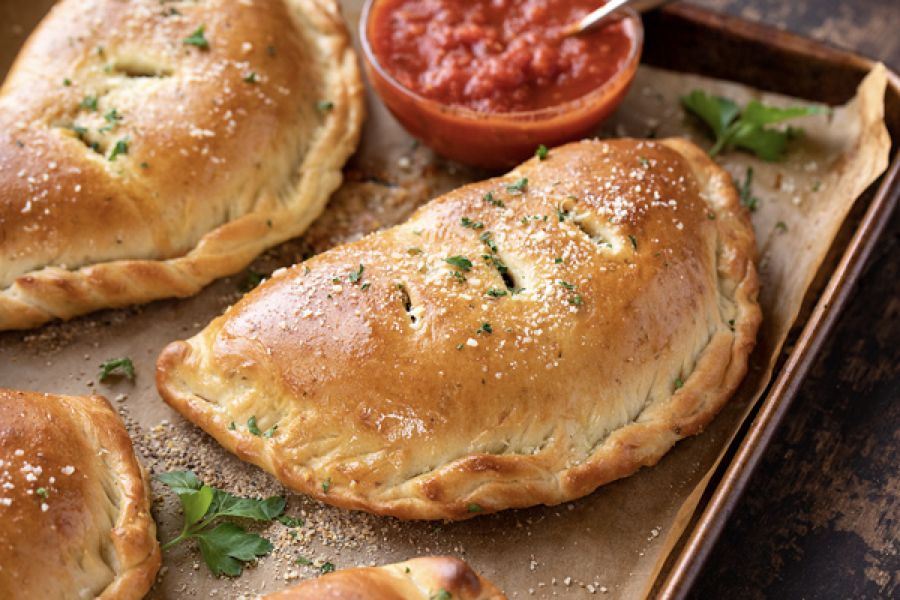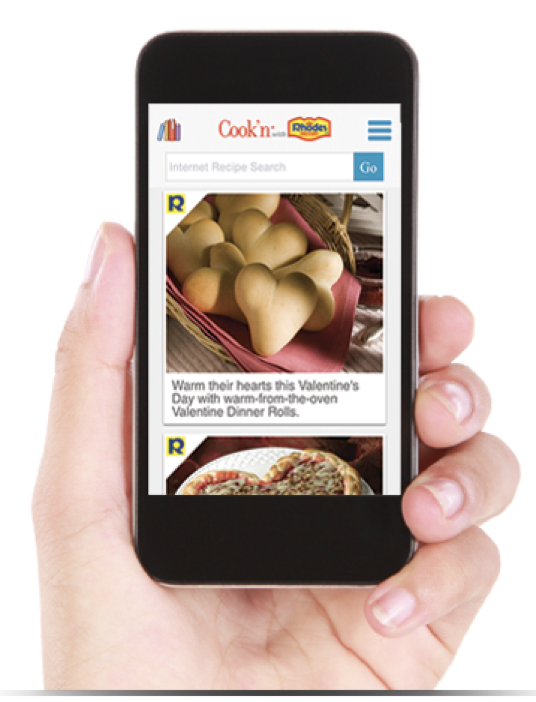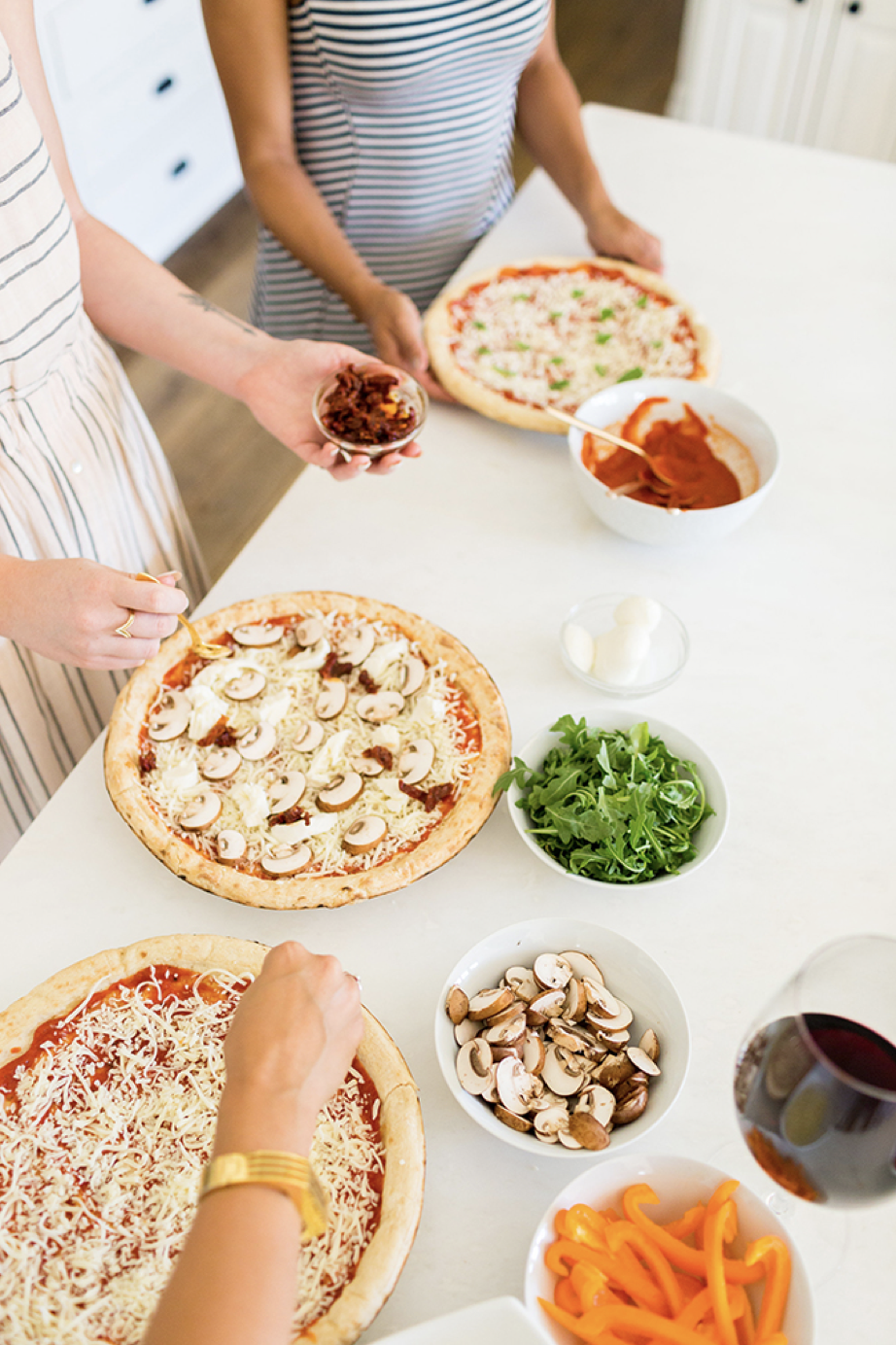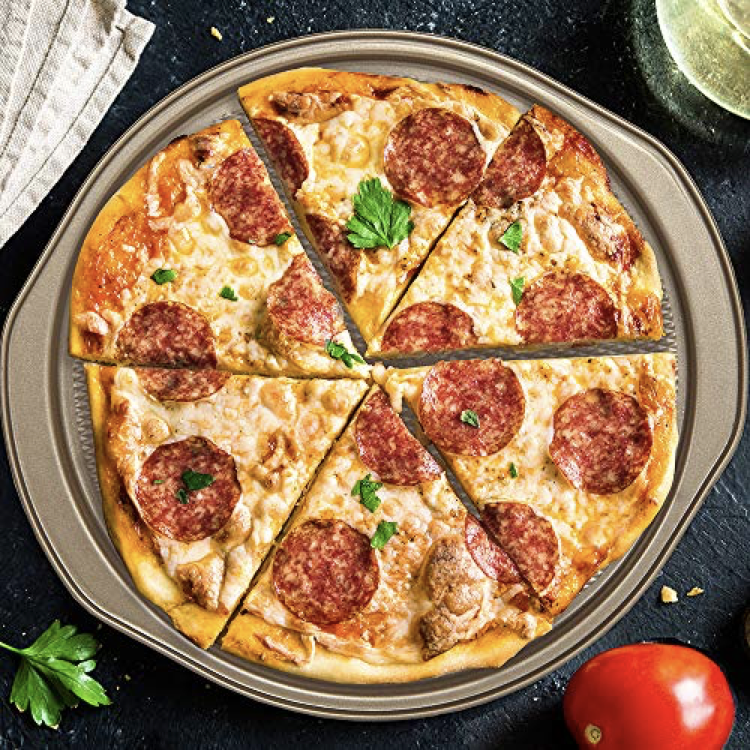Why Not PERSONAL PIZZAS for Your Next Party!
Instead of ordering pizza for your next gathering, why not provide your guests with their own ball of dough, roll it out, and then choose the toppings or fillings for their own personal pizza or calzone? With some planning and organization, this type of party would work well, no matter what size your kitchen is.

In most recipes, pizza dough is a plain bread dough that rises once before it is rolled out, topped and baked. A calzone is a turnover made with pizza dough and filled with some of the same ingredients that are used to top pizza. The fillings for calzones tend to include more mozzarella and ricotta and less tomato sauce than pizza toppings.
A calzone can be enjoyed as a hot sandwich or sliced and eaten at room temperature. And you’ll find these are even better the second day. When my children were home, I always made their school lunches, and calzones were a favorite school lunch meal.

Now, here’s how to pull this idea off: To streamline the process, prepare the dough in advance and refrigerate until friends and family are ready to roll. OR, don’t forget our all-time favorite, Rhodes Bake ‘n Serve Bread Dough.

It’s just perfect for this occasion and you’ll find if you do want to make the dough ahead of time, just wrap it tightly in plastic wrap and refrigerate until you’re ready to work with it. Allow an hour or so for it to reach room temperature. Dough can also be frozen for up to 3 months. Thaw it in its wrappings in the refrigerator for several hours, then bring it to room temperature.
Prepare the toppings or fillings and place them in separate bowls. These can be covered and refrigerated if necessary as well. Be sure to let them come to room temperature before using, though.
When it’s time to start the fun, divide the tasks amongst your guests. Have someone roll the dough into 12-inch circles (or smaller, if fricos are the choice). Someone else can spoon on and spread sauce. And of course, everyone will want to join in with the toppings process. Think the assembly line you see at Papa Murphey’s and you’ve got the right idea.

When it’s time to bake, preheat the oven for at least 20 minutes. It needs to be really hot when the pizza goes in. Keep your hands lightly floured while working with the dough so that it doesn’t stick. If the dough becomes springy while you roll it, give it a rest for about 5 minutes. If using Rhodes Dough, prick the rolled dough all over with a fork to keep it from puffing too much.
If your guests like a really crispy crust, ordinary baking sheets or round pizza pans dusted with cornmeal will work fine for the baking. However, just know that as the pizza bakes, the dough releases steam, which can make the crust soggy. There are a few ways to avoid the soggies, though:
Use a baking stone. They can be pricey, but are worth the investment if you enjoy making pizza or other flatbreads such as focaccia often. The thing to know when using one is to be sure to preheat the stone along with the oven.

A perforated pizza pan is another method. Tiny holes in the pan allow the steam to escape. Perforated pans are available in 13-, 14-, and 15-inch rounds.
If using a standard baking sheet, then remove the pizza off the pan at the last 10 minutes of baking and slide it onto the oven rack to complete its baking time.

When it comes to sauce, the trick is to be sure your sauce is a little thicker than for pasta. This is another technique to prevent a soggy bottom. I always cook my sauce down to thicken it.
Some pizza makers spread sauce directly on the prepared dough. Others brush he dough with a little olive oil and sprinkle it with grated Parmesan or another hard cheese before spooning on the sauce. Whichever you do, the goal is to avoid the soggies at all cost.
With all the football-watching parties we have lined up this season, I think a Make-Your-Own-Pizza approach will be a pleasant change. I think I’ll provide an apron for everyone and get ‘em working!
blog comments powered by Disqus

In most recipes, pizza dough is a plain bread dough that rises once before it is rolled out, topped and baked. A calzone is a turnover made with pizza dough and filled with some of the same ingredients that are used to top pizza. The fillings for calzones tend to include more mozzarella and ricotta and less tomato sauce than pizza toppings.
A calzone can be enjoyed as a hot sandwich or sliced and eaten at room temperature. And you’ll find these are even better the second day. When my children were home, I always made their school lunches, and calzones were a favorite school lunch meal.

Now, here’s how to pull this idea off: To streamline the process, prepare the dough in advance and refrigerate until friends and family are ready to roll. OR, don’t forget our all-time favorite, Rhodes Bake ‘n Serve Bread Dough.

It’s just perfect for this occasion and you’ll find if you do want to make the dough ahead of time, just wrap it tightly in plastic wrap and refrigerate until you’re ready to work with it. Allow an hour or so for it to reach room temperature. Dough can also be frozen for up to 3 months. Thaw it in its wrappings in the refrigerator for several hours, then bring it to room temperature.
Prepare the toppings or fillings and place them in separate bowls. These can be covered and refrigerated if necessary as well. Be sure to let them come to room temperature before using, though.
When it’s time to start the fun, divide the tasks amongst your guests. Have someone roll the dough into 12-inch circles (or smaller, if fricos are the choice). Someone else can spoon on and spread sauce. And of course, everyone will want to join in with the toppings process. Think the assembly line you see at Papa Murphey’s and you’ve got the right idea.

When it’s time to bake, preheat the oven for at least 20 minutes. It needs to be really hot when the pizza goes in. Keep your hands lightly floured while working with the dough so that it doesn’t stick. If the dough becomes springy while you roll it, give it a rest for about 5 minutes. If using Rhodes Dough, prick the rolled dough all over with a fork to keep it from puffing too much.
If your guests like a really crispy crust, ordinary baking sheets or round pizza pans dusted with cornmeal will work fine for the baking. However, just know that as the pizza bakes, the dough releases steam, which can make the crust soggy. There are a few ways to avoid the soggies, though:
Use a baking stone. They can be pricey, but are worth the investment if you enjoy making pizza or other flatbreads such as focaccia often. The thing to know when using one is to be sure to preheat the stone along with the oven.

A perforated pizza pan is another method. Tiny holes in the pan allow the steam to escape. Perforated pans are available in 13-, 14-, and 15-inch rounds.
If using a standard baking sheet, then remove the pizza off the pan at the last 10 minutes of baking and slide it onto the oven rack to complete its baking time.

When it comes to sauce, the trick is to be sure your sauce is a little thicker than for pasta. This is another technique to prevent a soggy bottom. I always cook my sauce down to thicken it.
Some pizza makers spread sauce directly on the prepared dough. Others brush he dough with a little olive oil and sprinkle it with grated Parmesan or another hard cheese before spooning on the sauce. Whichever you do, the goal is to avoid the soggies at all cost.
With all the football-watching parties we have lined up this season, I think a Make-Your-Own-Pizza approach will be a pleasant change. I think I’ll provide an apron for everyone and get ‘em working!
Sources:
- www.artisanpizzakitchen.com
- www.thecozyapron.com
- www.dvo.com
- www.leitesculinaria.com
- www.laurenconrad.com
- www.pricepulseapp.com
 Alice Osborne
Alice Osborne
Weekly Newsletter Contributor since 2006
Email the author! alice@dvo.com
